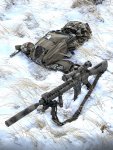Small sample sizes are a natural thing,
Nobody wants to waste 20 rounds on paper to make one hole,
you combined a ton of data in YOUR version, but nobody does that consistently at all. While I write everything down, I don't need all this extra data regardless of your scientific method, we get it, we use 3 and 5 shots, it's been explained why because we don't need to keep doing the same thing over and over in order to "see" what the results would be... they only time I would consider this is diagnosing a problem and most cant be fixed in less.
I don't even waste my time with a chronograph any more, not in my class, not at home by myself, I have no reason to use one in most cases. I can take software, shoot a target, and align the software up to give me a number. I am using a different kind of math to solve for X vs the math used to solve for Y... That number will not change because I will end up using that information in the software moving forward. If the actual value is 2825fps and I have 2835fps in the software because I winged it and I got it by shooting at 600 yards and then aligning the drop up, what difference does it make? Just like you said, what is the difference if I do it that way or with a chronograph at 100 yards? The relevant data is the same. Either the software will change my chronograph number or I can let it upfront by asking it what it wants. The only difference is I cut out a step, I took a shortcut.
I would rather take the 20 shots and march out to distance with them, recording that data because it will tell me more than wasting 20 at 100 yards. Heck, some days I zero on steel at 200 yards, slip the scales to my 200yd dope and let it sit there. The wind just blows paper around on my range, hate chasing it.
@Ledzep
You ask why the hostility because you want us to do something NOBODY but a select few will do, you want to fundamentally change the way we look at everything because you want a bigger sample size, LOL, think about that a second because you are totally saying, my way is the only way to "know" when everyone else says, NO we can figure all this out another way, without doing it your way. The one person outside the box here is you, not us. why does this industry not use bigger sample sizes because 100 years ago we found out it wasn't needed. No company started out giving 20 shot accuracy guarantees and then change it, it's always been this way, and it works. 3 for the rifle, 5 for the shooter, any variation of that is personal preference.
You face hostility because you are crossed your arms and proclaimed, "doesn't count" so as I said before, fuck off, go to bench rest central they will embrace your thinking. But that is in no way, shape, or form how the majority of us operate.
If I chronograph my rifle with 5 shots at 100 I get one number, if I chronograph 50 shots that number changes slightly, sure it will depend on the ammo, and if I was handloading I would be testing more in the beginning. But once the process is established once the method is determined to be solid, we take shortcuts. We are not writing peer-reviewed scientific papers, most of us know if I post a 5 shot group what I am saying. Posting 5 versions of it is a waste of time, a picture speaks 1000 words. There is your sample size, translate it.
You have a process that process includes a high-speed spreadsheet with all kinds of data, I don't care that much about my information to sweat it. It's unnecessary in my world, so stop trying to put that OCD on everyone. Not everyone wants to approach shooting like a science experiment. Some do it because they enjoy it and don't want to treat it like a job or science class.
These debates are tired, they are unproductive, and sitting there repeating, "sample size", "doesn't count", is tedious and a bigger waste of everyone's time because maybe 2 people will agree with you and do it. The majority won't shoot 5 and you want 20, smart hill to die on... 1996 called and wants their 15 minutes back.
PS weaponized math was designed to shoot less, instead of wasting 10 rounds to dope a rifle we wanted to do it in 3, the smaller sample size was to move more people through effectively. We designed it to fix reconning by fire on a target when a person is missing information. This gets you on in 1 shot, less shooting.




